As an avid aquarist, I have always been fascinated by the Flowerhorn Cichlid. This hybrid fish, a cross between several different cichlid species, is known for its striking appearance and unique personality. However, caring for a Flowerhorn can be a challenge, especially for those new to the hobby. In this article, I will share everything you need to know about Flowerhorn Cichlid care.
Flowerhorn Cichlids require a large aquarium with good filtration and hiding places. They are aggressive and should be kept alone or with large, robust fish. They feed on high-quality pellets and frozen foods. Regular water changes and maintenance are essential for their health.
First and foremost, it’s important to understand that Flowerhorns are a large and active fish that require a spacious aquarium with plenty of room to swim. A tank size of at least 75 gallons is recommended, and filtration should be strong enough to handle the high waste output of these fish. Additionally, Flowerhorns are known for their aggressive tendencies, so it’s important to choose tankmates carefully and provide plenty of hiding places and territories to prevent fights.
When it comes to feeding, Flowerhorns are omnivorous and will eat a variety of foods, including pellets, flakes, frozen and live foods. However, it’s important to avoid overfeeding, as Flowerhorns are prone to obesity and related health issues. By following these basic guidelines and providing the right care, you can enjoy the beauty and personality of Flowerhorn Cichlids in your own aquarium.
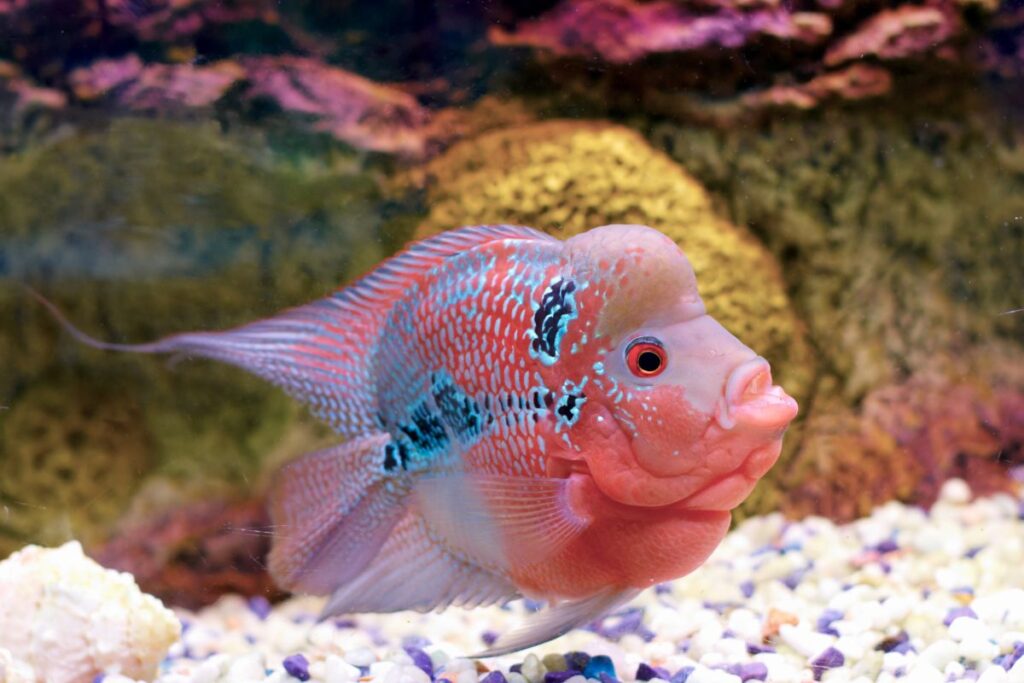
Table of Contents
Species Summary
Flowerhorn Cichlids are a popular fish species among aquarium enthusiasts. They are known for their unique appearance and behavior.
In this section, we will discuss the origin, lifespan, appearance, size, growth rate, behavior & temperament, and male vs female characteristics of Flowerhorn Cichlids.
Origin
Flowerhorn Cichlids were first created in Malaysia in the late 1990s by crossbreeding various cichlid species.
They were specifically bred to have a unique appearance, which includes a hump on their head and vibrant colors. Today, they are bred in many countries and are popular in the aquarium trade.
Lifespan
The average lifespan of Flowerhorn Cichlids is about 10-12 years. However, with proper care and a healthy diet, they can live up to 15 years.
It’s important to provide them with a suitable environment and good water quality to ensure they live a long and healthy life.
Appearance
Flowerhorn Cichlids are known for their unique appearance, which includes a prominent hump on their head and bright colors.
Their body shape is similar to other cichlids, but their hump sets them apart. They come in a variety of colors, including red, orange, yellow, and blue.
Size
Flowerhorn Cichlids can grow up to 12-16 inches in length. They are considered a large fish species and require a spacious aquarium to thrive.
It’s important to keep in mind their potential size when selecting a tank for them.
Growth Rate
The growth rate of Flowerhorn Cichlids can vary depending on various factors, including diet, water quality, and tank size.
They typically grow about 1-2 inches per year, but some may grow faster or slower than others.
Behavior & Temperament
Flowerhorn Cichlids are known for their aggressive behavior and territorial nature.
They are not recommended for community tanks and should be kept alone or with other large, aggressive fish species.
It’s important to provide them with plenty of hiding places and territory to prevent aggression towards other fish.
Male vs Female
Male and female Flowerhorn Cichlids can be distinguished by their genital papilla. Males have a pointed papilla, while females have a rounder, more blunt papilla.
Males also tend to have more vibrant colors and a larger hump on their head than females.
Personally, I have always been fascinated by Flowerhorn Cichlids. Their unique appearance and behavior make them an interesting addition to any aquarium.
However, it’s important to provide them with proper care and a suitable environment to ensure they live a long and healthy life.
Tank Setup
Setting up the perfect tank for your Flowerhorn Cichlid is vital to their health and happiness.
Here are some important factors to consider when setting up your tank:
Tank Size
The recommended tank size for a Flowerhorn Cichlid is at least 75 gallons. This will give them plenty of space to swim and grow.
I made the mistake of starting with a smaller tank, and my Flowerhorn was always stressed and unhappy until I upgraded to a larger tank.
Lighting
Flowerhorn Cichlids need a consistent light cycle to maintain their health. A good rule of thumb is to provide 8-10 hours of light per day.
I recommend using a timer to ensure that the light cycle is consistent.
Filtration & Aeration
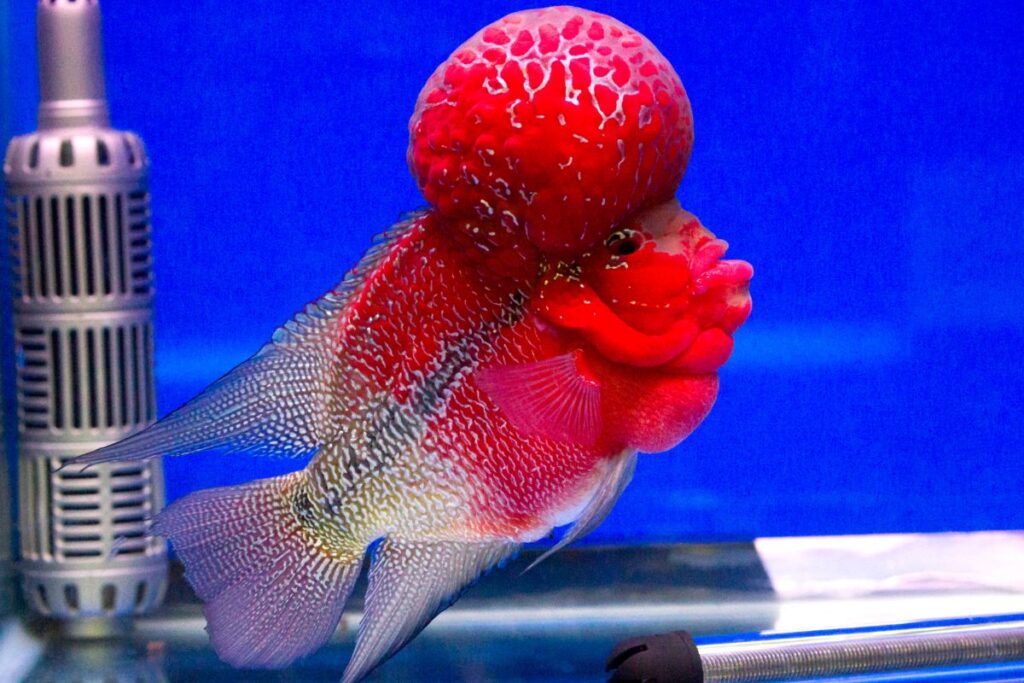
Proper filtration and aeration are essential for maintaining good water quality. A canister filter is a great option for Flowerhorn tanks, as it provides both mechanical and biological filtration.
I also recommend using an air stone or bubbler to increase oxygen levels in the water.
Heater
Flowerhorn Cichlids are tropical fish and require a consistent water temperature between 78-82°F. A good quality heater is essential to maintain the proper temperature.
I recommend using a heater with a built-in thermostat to ensure accuracy.
Substrate
The substrate you choose for your Flowerhorn tank can have a big impact on their health and happiness. I prefer using sand as it is easy to clean and maintain.
Make sure to avoid sharp or rough substrates that can damage your fish’s delicate fins.
Decoration
Adding decorations to your Flowerhorn tank can provide hiding places and stimulation for your fish.
I recommend using natural-looking decorations such as rocks, driftwood, and caves. Avoid using decorations with sharp edges or small openings that your fish can get stuck in.
Plants
While Flowerhorn Cichlids don’t necessarily need live plants in their tank, they can provide additional hiding places and help maintain water quality.
If you choose to use live plants, make sure they are compatible with your fish and won’t be uprooted easily.
Water Quality
As an avid Flowerhorn Cichlid enthusiast, I know that maintaining good water quality is essential for the health and well-being of these beautiful fish.
Here are some key factors to keep in mind when it comes to water quality:
Water Temperature
The ideal water temperature for Flowerhorn Cichlids is between 78°F and 82°F. I use a reliable aquarium thermometer to monitor the temperature and make adjustments as needed.
It’s important to avoid sudden changes in temperature, as this can stress the fish and make them more susceptible to illness.
Water pH
Flowerhorn Cichlids prefer slightly alkaline water with a pH between 7.4 and 8.0.
I use a high-quality pH test kit to monitor the pH levels in my aquarium regularly. If the pH is too low, I add a pH increaser to raise it to the appropriate level.
Water Hardness
These fish require moderately hard water with a hardness level between 8 and 12 dGH. I check the water hardness levels in my aquarium using a test kit and make adjustments as needed.
If the water is too soft, I add a water hardener to bring it up to the appropriate level.
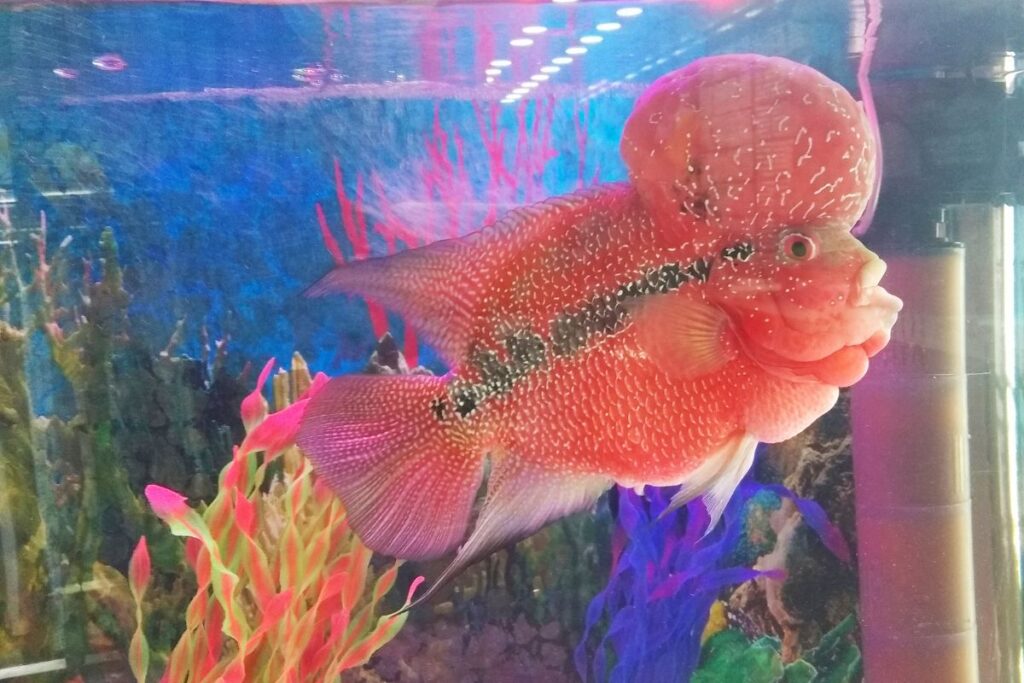
Water Changes
Regular water changes are essential for maintaining good water quality in your Flowerhorn Cichlid aquarium. I typically change 20-30% of the water in my aquarium every week to remove any accumulated waste and debris.
It’s important to use a high-quality water conditioner to remove any harmful chemicals or toxins from tap water before adding it to the aquarium.
By paying close attention to these key factors, you can ensure that your Flowerhorn Cichlids thrive in a healthy and clean environment. Remember, healthy fish are happy fish!
Personally, I have found that maintaining good water quality is one of the most rewarding aspects of keeping Flowerhorn Cichlids.
Seeing my fish thrive and grow in a clean and healthy environment brings me a great sense of joy and satisfaction.
Tank Maintenance
Proper tank maintenance is crucial for the health and well-being of your Flowerhorn Cichlid.
As an owner of a Flowerhorn Cichlid, I have learned the importance of keeping the tank clean and well-maintained.
One of the most important aspects of tank maintenance is regular water changes. I typically change 25% of the water in my Flowerhorn’s tank every two weeks.
This helps to remove any built-up waste and debris, while also ensuring that the water quality remains high.
In addition to water changes, it’s important to regularly clean the tank itself.
This includes removing any uneaten food or waste, as well as scrubbing the sides of the tank to remove any algae buildup. I find that using a magnetic algae scrubber makes this task much easier.
Another important aspect of tank maintenance is monitoring the water parameters. I regularly test the water for pH, ammonia, nitrite, and nitrate levels using a test kit.
This helps me to quickly identify any potential issues and take corrective action before they become a problem.
Finally, it’s important to regularly inspect all equipment, including the filter and heater, to ensure that everything is working properly.
I typically do this during each water change, as it’s a good opportunity to check everything at once.
Overall, proper tank maintenance is essential for the health and well-being of your Flowerhorn Cichlid. By following these simple tips, you can help ensure that your fish stays happy and healthy for years to come.
Tank Mates
Compatible Fish Species
I have found that Flowerhorn Cichlids are generally compatible with fish that are similar in size and temperament.
Some good options include Oscar fish, Jack Dempsey fish, and Convict fish. These fish can all coexist peacefully with Flowerhorns and make great tank mates.
Incompatible Fish Species
On the other hand, there are some fish species that should be avoided as tank mates for Flowerhorn Cichlids. These include smaller and more passive fish like tetras and guppies.
These types of fish may be seen as prey by Flowerhorns and can lead to aggressive behavior.
How Many Flowerhorn Fish Should be Kept Together
When it comes to keeping Flowerhorn Cichlids together, it’s important to remember that these fish can be quite territorial. As a general rule, it’s best to keep only one Flowerhorn per tank.
However, if you have a large enough tank, you may be able to keep multiple Flowerhorns together as long as they are of similar size and temperament.
It’s important to monitor their behavior closely and separate them if any aggression is observed. In summary, when choosing tank mates for your Flowerhorn Cichlid, it’s important to consider their size and temperament.
Compatible fish species include Oscar fish, Jack Dempsey fish, and Convict fish, while smaller and more passive fish should be avoided.
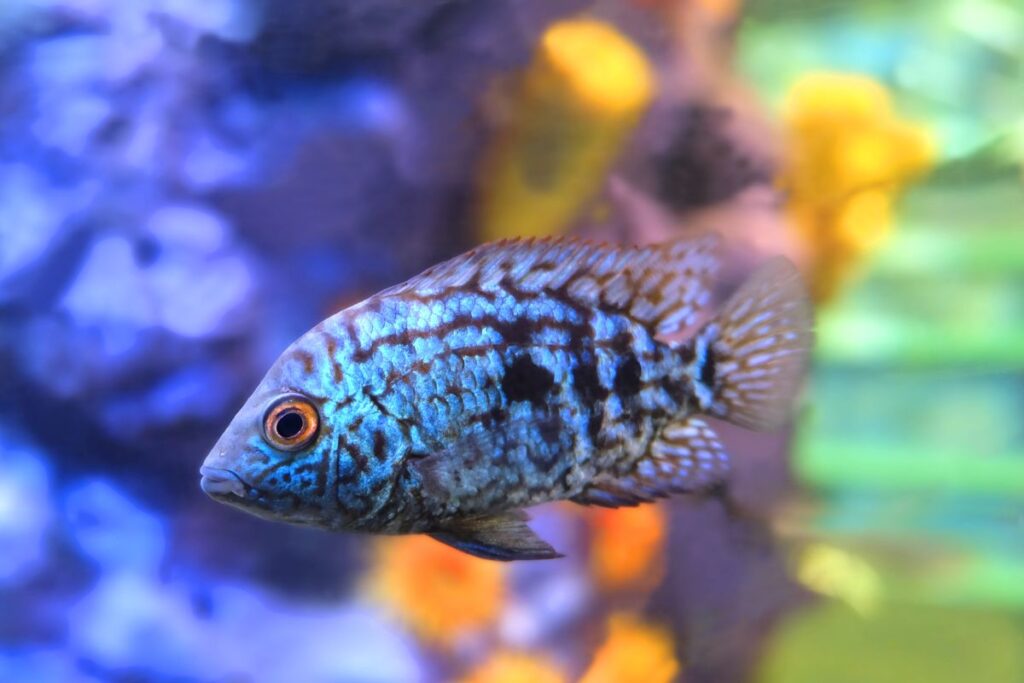
When keeping multiple Flowerhorns together, it’s best to only keep one per tank unless you have a large enough tank to accommodate multiple fish.
Diet
What To Feed
When it comes to Flowerhorn Cichlid diet, variety is key. I usually feed my Flowerhorn Cichlid a mixture of pellets, frozen food, and live food.
Pellets should make up the bulk of their diet, but it’s important to supplement it with other types of food.
For pellets, I recommend high-quality brands that are specifically formulated for Flowerhorn Cichlids.
These pellets usually contain a high percentage of protein and other essential nutrients that your fish needs to thrive.
Frozen food such as bloodworms, brine shrimp, and krill are also great options.
These foods are rich in protein and are usually sold in small cubes that you can thaw before feeding to your fish.
Live food such as earthworms, crickets, and feeder fish are also great options. However, be careful when feeding live food as they can carry diseases that can harm your fish if not properly quarantined.
Frequency
When it comes to feeding your Flowerhorn Cichlid, it’s important to strike a balance between underfeeding and overfeeding.
I usually feed my fish twice a day, once in the morning and once in the evening. I feed them only as much as they can eat in a few minutes, removing any leftover food to prevent it from fouling the water.
It’s important to not overfeed your fish as this can lead to health problems such as obesity and swim bladder disease.
On the other hand, underfeeding your fish can also lead to health problems such as stunted growth and weakened immune system.
Tips
Here are a few tips to keep in mind when feeding your Flowerhorn Cichlid:
- Make sure to vary their diet to ensure they get all the necessary nutrients.
- Always feed them high-quality food to ensure they stay healthy.
- Don’t overfeed your fish as this can lead to health problems.
- Remove any leftover food to prevent it from fouling the water.
- Quarantine any live food before feeding it to your fish to prevent the spread of diseases.
By following these tips, you can ensure that your Flowerhorn Cichlid stays healthy and happy.
Personally, I love watching my Flowerhorn Cichlid eat. It’s amazing to see how quickly they can devour their food.
I’ve also noticed that they tend to be more active and playful after a good meal. It’s a great feeling knowing that I’m providing them with the proper nutrition they need to thrive.
Common Diseases
As a Flowerhorn Cichlid owner, it’s important to be aware of the common diseases that can affect your fish.
Here are some of the most common diseases, along with their symptoms, treatment, and prevention.
Diseases
One of the most common diseases that Flowerhorn Cichlids can get is Ich, which is caused by a parasite. Other diseases include fin rot, bacterial infections, and swim bladder disease.
Symptoms
The symptoms of Ich include white spots on the fish’s body, while fin rot is characterized by ragged fins.
Bacterial infections can cause ulcers and red streaks on the fish’s body, and swim bladder disease can cause the fish to have difficulty swimming and staying upright.
Treatment
The treatment for Ich involves raising the temperature of the water and adding medication to kill the parasite.
Fin rot can be treated by improving water quality and adding medication to prevent the spread of the infection.
Bacterial infections can be treated with antibiotics, and swim bladder disease can be treated by feeding the fish a high-fiber diet and adjusting the water temperature.
Prevention
The best way to prevent diseases in Flowerhorn Cichlids is to maintain good water quality and avoid overfeeding.
It’s also important to quarantine new fish before adding them to your tank to prevent the spread of diseases. Regular water changes and tank cleanings can also help prevent diseases from taking hold.
Personally, I’ve had to deal with fin rot in one of my Flowerhorn Cichlids. It was a stressful experience, but with the help of a knowledgeable pet store employee and some medication, my fish made a full recovery. It’s important to stay vigilant and catch any signs of disease early to give your fish the best chance of recovery.
Signs of a Healthy Flowerhorn
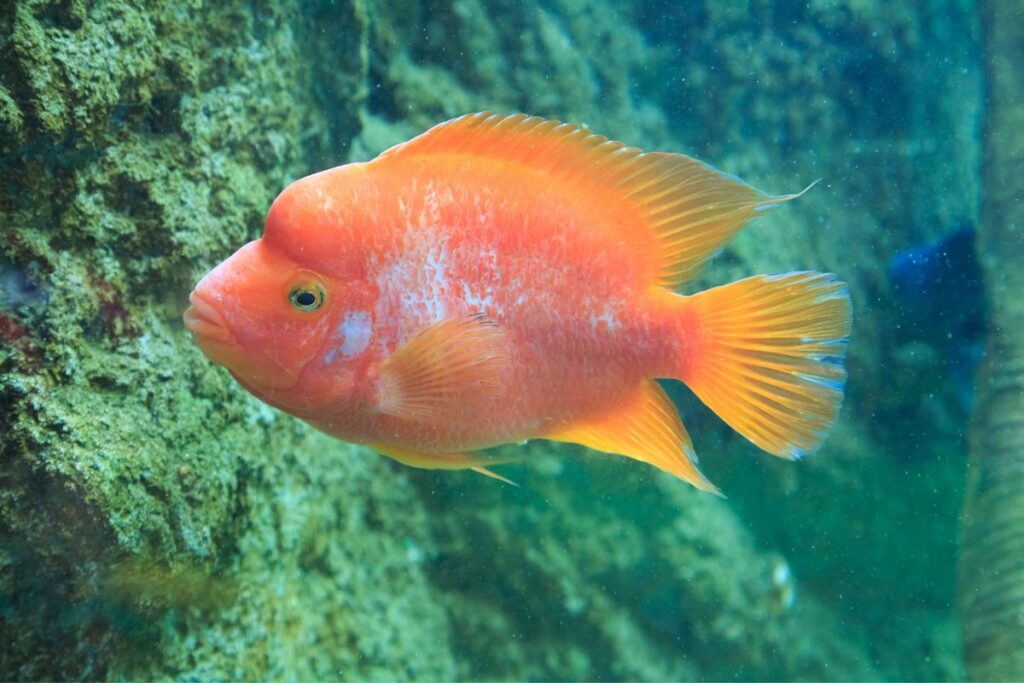
As a Flowerhorn owner, I know how important it is to keep these fish healthy and happy. Here are a few signs that your Flowerhorn is healthy:
- Bright and Vibrant Colors: A healthy Flowerhorn will have bright and vibrant colors. If your fish looks dull or faded, it may be a sign of poor health.
- Active and Energetic: A healthy Flowerhorn will be active and energetic. If your fish is lethargic or spends most of its time hiding, it may be a sign of illness.
- Good Appetite: A healthy Flowerhorn will have a good appetite and eagerly eat its food. If your fish is not eating or has a decreased appetite, it may be a sign of illness.
- Clean Fins and Body: A healthy Flowerhorn will have clean fins and body. If your fish has torn or ragged fins, it may be a sign of poor water quality or aggression from tank mates.
- Clear Eyes and No Signs of Disease: A healthy Flowerhorn will have clear eyes and no signs of disease. If your fish has cloudy or bulging eyes, white spots, or any other signs of disease, it may be a sign of illness.
Keep in mind that these signs are not definitive and may vary depending on the individual fish. However, if you notice any of these signs, it is a good indication that your Flowerhorn is healthy and happy.
Personally, I always make sure to observe my Flowerhorn’s behavior and appearance on a daily basis. This helps me catch any signs of illness early on and take action to keep my fish healthy.
Remember, prevention is key when it comes to keeping your Flowerhorn healthy!
Signs Your Flowerhorn is Sick
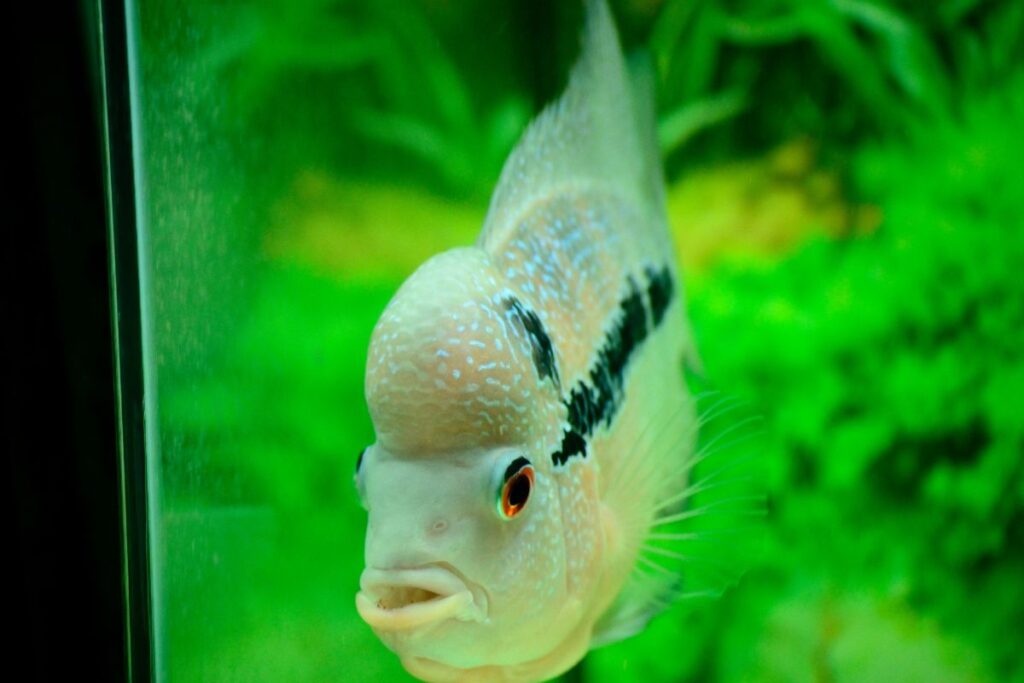
As a Flowerhorn owner, it’s important to keep a close eye on your fish to ensure they are healthy and happy. Here are some signs that your Flowerhorn may be sick:
- Loss of appetite: If your Flowerhorn is not eating or showing a lack of interest in food, it could be a sign of illness.
- Abnormal swimming behavior: If your Flowerhorn is swimming erratically or struggling to stay upright, it could be a sign of swim bladder disease.
- Discoloration: If your Flowerhorn’s colors are fading or becoming dull, it could be a sign of stress or illness.
- Clamped fins: If your Flowerhorn’s fins are clamped close to its body, it could be a sign of stress or illness.
- Rapid breathing: If your Flowerhorn is breathing rapidly or gasping for air, it could be a sign of poor water quality or illness.
If you notice any of these signs, it’s important to take action quickly to ensure your Flowerhorn receives proper care.
Check your water quality and make sure your tank is properly maintained. Consider consulting with a veterinarian who specializes in fish care to get a proper diagnosis and treatment plan.
Personally, I once noticed that my Flowerhorn was not eating as much as usual and seemed to be hiding more often. I immediately checked my water quality and found that my tank was not properly cycled. I did a water change and added some beneficial bacteria to help establish a healthy environment for my fish. Within a few days, my Flowerhorn was back to its normal, active self and eating normally.
Breeding
Breeding Setup
Before breeding Flowerhorn Cichlids, it is important to have the right setup. I recommend using a tank that is at least 100 gallons in size, as Flowerhorns can grow quite large.
The tank should have a pH of 7.0-8.0 and a temperature of 80-82°F. You should also provide plenty of hiding places and a flat surface for the female to lay her eggs on.
How To Breed
To breed Flowerhorn Cichlids, you will need a male and a female. The male will typically be more colorful and have a larger nuchal hump on his head.
Once you have a male and female, you can introduce them to the breeding tank. The male will typically start to court the female by displaying his fins and colors.
Once the female is ready to lay eggs, she will lay them on the flat surface you provided. The male will then fertilize the eggs.
After the eggs have been fertilized, you should remove the female from the tank. The male will then take care of the eggs and fry.
It is important to provide plenty of food for the fry, as they will grow quickly. You can feed them a diet of brine shrimp, crushed flakes, and other small foods.
Care
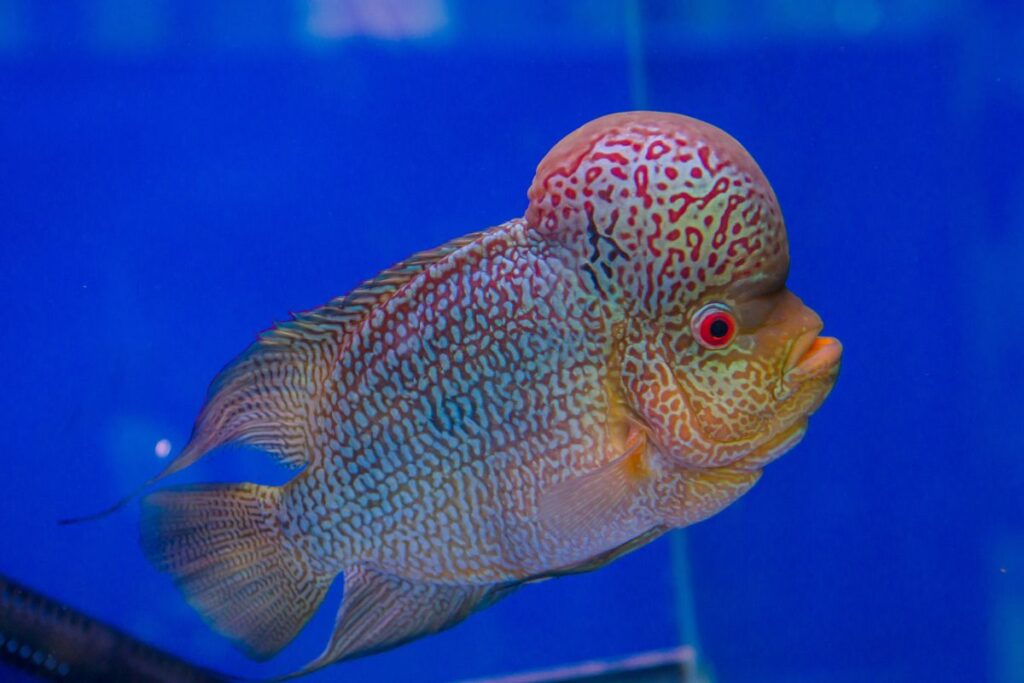
When breeding Flowerhorn Cichlids, it is important to monitor the water quality closely. You should perform regular water changes to ensure that the water remains clean and healthy for the fry.
You should also provide plenty of hiding places and a varied diet for the fry to ensure that they grow up healthy and strong.
Personally, I have found breeding Flowerhorn Cichlids to be a rewarding experience. Watching the male take care of the eggs and fry is truly amazing. However, it is important to remember that breeding can be a challenging and time-consuming process. Make sure you are prepared before attempting to breed Flowerhorn Cichlids.
Product recommendations for Flowerhorn Cichlid:
- Hikari Cichlid Gold– This is a high-quality fish food that is perfect for Flowerhorn Cichlid. It contains all the essential nutrients that your fish need to stay healthy and vibrant.
- API Aquarium Test Kit – It is important to keep an eye on the water quality in your aquarium, and this test kit makes it easy to do so. It includes tests for ammonia, nitrite, nitrate, and pH.
- Seachem Prime – This is a water conditioner that helps to detoxify ammonia, nitrite, and nitrate in your aquarium. It is safe for use with Flowerhorn Cichlid and other fish.
- Fluval Plant and Shrimp Stratum – If you plan on keeping live plants in your aquarium, this substrate is a great choice. It provides the nutrients that plants need to thrive, and also helps to maintain a stable pH.
- AquaClear Power Filter – This filter is highly effective at removing debris and maintaining water quality in your aquarium. It is also very quiet and easy to maintain.
- Aqueon Aquarium Water Changer – This device makes it easy to perform regular water changes in your aquarium. It is designed to be safe and easy to use, and can help to keep your Flowerhorn Cichlid healthy.
- Zoo Med Nano 10 External Canister Filter – This is a small and efficient filter that is perfect for smaller aquariums housing Flowerhorn Cichlid. It is easy to install and maintain, and will keep the water in your aquarium clean and healthy.
- Marina LED Aquarium Kit– This is another great aquarium kit that is perfect for Flowerhorn Cichlid. It includes a filter, heater, and LED lighting, and is easy to set up and maintain.
Conclusion
After years of keeping Flowerhorn Cichlids, I can confidently say that they are one of the most fascinating and rewarding fish to care for. While they do require a bit more attention and care than some other fish, the effort is well worth it.
Throughout this article, I’ve covered everything you need to know about Flowerhorn Cichlid care. From tank setup and water parameters to feeding and breeding, I’ve provided you with all the information you need to create a healthy and thriving environment for your fish.
Remember to always do your research before making any changes to your fish’s environment or diet. And don’t be afraid to ask for help if you’re unsure about something. There are plenty of resources available, including online forums and local fish stores, where you can get advice and support from experienced hobbyists.
Finally, I want to emphasize the importance of patience when it comes to Flowerhorn Cichlid care. These fish can live for up to 10 years or more, so it’s important to take the time to create a stable and healthy environment for them to thrive in.
With a little patience and dedication, you can create a beautiful and rewarding home for your Flowerhorn Cichlid.
I hope this article has been helpful and informative for you. If you have any questions or comments, feel free to reach out to me. And remember, happy fish keeping!
FAQs
As a Flowerhorn Cichlid owner, I often get asked a lot of questions about how to properly care for these beautiful fish. Here are some of the most frequently asked questions:
Q: What is the best tank size for a Flowerhorn Cichlid?
A: Flowerhorn Cichlids can grow quite large, so it’s important to provide them with a tank that is at least 75 gallons. However, if you want your fish to grow to their full potential, a 125-gallon tank or larger is recommended.
Q: What should I feed my Flowerhorn Cichlid?
A: Flowerhorn Cichlids are omnivores and require a balanced diet of both protein and vegetables. High-quality pellets, frozen or live foods such as shrimp, krill, or worms, and fresh vegetables like peas or spinach are all great options.
Q: How often should I clean my Flowerhorn Cichlid’s tank?
A: It’s important to maintain good water quality in your Flowerhorn Cichlid’s tank. A partial water change of 25% should be done every two weeks, with a full water change every month.
Q: Can Flowerhorn Cichlids live with other fish?
A: Flowerhorn Cichlids are known for their aggressive behavior and territorial nature, so it’s best to keep them in a species-only tank. However, if you have a large enough tank, you can keep them with other large, aggressive fish that can hold their own.
Q: How can I tell if my Flowerhorn Cichlid is sick?
A: Signs of illness in Flowerhorn Cichlids include loss of appetite, lethargy, discoloration, and abnormal behavior. If you notice any of these symptoms, it’s important to seek veterinary care immediately.
Overall, Flowerhorn Cichlids are fascinating fish that require proper care and attention. By following these tips and guidelines, you can ensure that your Flowerhorn Cichlid thrives in its environment.
Personally, I love watching my Flowerhorn Cichlid swim around its tank and interact with me. It’s important to remember that these fish have unique personalities and should be treated with care and respect. By providing them with a suitable environment and proper care, you can enjoy the beauty of your Flowerhorn Cichlid for years to come.
Reference: Wikipedia.
